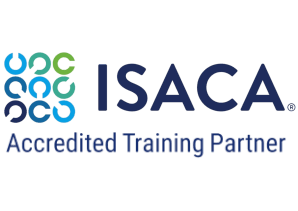 Certificate
Certificate
Course Outline
Goal:
The ultimate goal is to pass your CISA examination first time.
Information System Auditing Process (21%)
Provide audit services in accordance with IT audit standards to assist the organization in protecting and controlling information systems.
- 1.1 Develop and implement a risk-based IT audit strategy in compliance with IT audit standards to ensure that key areas are included.
- 1.2 Plan specific audits to determine whether information systems are protected, controlled and provide value to the organization.
- 1.3 Conduct audits in accordance with IT audit standards to achieve planned audit objectives.
- 1.4 Report audit findings and make recommendations to key stakeholders to communicate results and effect change when necessary.
- 1.5 Conduct follow-ups or prepare status reports to ensure appropriate actions have been taken by management in a timely manner.
Governance and Management of IT (17%)
Provide assurance that the necessary leadership and organization structure and processes are in place to achieve objectives and to support the organization's strategy.
- 2.1 Evaluate the effectiveness of the IT governance structure to determine whether IT decisions, directions and performance support the organization’s strategies and objectives.
- 2.2 Evaluate IT organizational structure and human resources (personnel) management to determine whether they support the organization’s strategies and objectives.
- 2.3 Evaluate the IT strategy, including the IT direction, and the processes for the strategy’s development, approval, implementation and maintenance for alignment with the organization’s strategies and objectives.
- 2.4 Evaluate the organization’s IT policies, standards, and procedures, and the processes for their development, approval, implementation, maintenance, and monitoring, to determine whether they support the IT strategy and comply with regulatory and legal requirements.
- 2.5 Evaluate the adequacy of the quality management system to determine whether it supports the organization’s strategies and objectives in a cost-effective manner.
- 2.6 Evaluate IT management and monitoring of controls (e.g., continuous monitoring, QA) for compliance with the organization’s policies, standards and procedures.
- 2.7 Evaluate IT resource investment, use and allocation practices, including prioritization criteria, for alignment with the organization’s strategies and objectives.
- 2.8 Evaluate IT contracting strategies and policies, and contract management practices to determine whether they support the organization’s strategies and objectives.
- 2.9 Evaluate risk management practices to determine whether the organization’s IT-related risks are properly managed.
- 2.10 Evaluate monitoring and assurance practices to determine whether the board and executive management receive sufficient and timely information about IT performance.
- 2.11 Evaluate the organization’s business continuity plan to determine the organization’s ability to continue essential business operations during the period of an IT disruption.
Information Systems Acquisition, Development and implementation (12%)
Provide assurance that the practices for the acquisition, development, testing, and implementation of information systems meet the organization’s strategies and objectives.
- 3.1 Evaluate the business case for the proposed investments in information systems acquisition, development, maintenance and subsequent retirement to determine whether it meets business objectives.
- 3.2 Evaluate the project management practices and controls to determine whether business requirements are achieved in a cost-effective manner while managing risks to the organization.
- 3.3 Conduct reviews to determine whether a project is progressing in accordance with project plans, is adequately supported by documentation and status reporting is accurate.
- 3.4 Evaluate controls for information systems during the requirements, acquisition, development and testing phases for compliance with the organization's policies, standards, procedures and applicable external requirements.
- 3.5 Evaluate the readiness of information systems for implementation and migration into production to determine whether project deliverables, controls and organization's requirements are met.
- 3.6 Conduct post-implementation reviews of systems to determine whether project deliverables, controls and organization's requirements are met.
Information Systems Operation and Business Resilience (23%)
Provide assurance that the processes for information systems operations, maintenance and support meet the organization’s strategies and objectives.
- 4.1 Conduct periodic reviews of information systems to determine whether they continue to meet the organization’s objectives.
- 4.2 Evaluate service level management practices to determine whether the level of service from internal and external service providers is defined and managed.
- 4.3 Evaluate third party management practices to determine whether the levels of controls expected by the organization are being adhered to by the provider.
- 4.4 Evaluate operations and end-user procedures to determine whether scheduled and non-scheduled processes are managed to completion.
- 4.5 Evaluate the process of information systems maintenance to determine whether they are controlled effectively and continue to support the organization’s objectives.
- 4.6 Evaluate data administration practices to determine the integrity and optimization of databases.
- 4.7 Evaluate the use of capacity and performance monitoring tools and techniques to determine whether IT services meet the organization’s objectives.
- 4.8 Evaluate problem and incident management practices to determine whether incidents, problems or errors are recorded, analyzed and resolved in a timely manner.
- 4.9 Evaluate change, configuration and release management practices to determine whether scheduled and non-scheduled changes made to the organization’s production environment are adequately controlled and documented.
- 4.10 Evaluate the adequacy of backup and restore provisions to determine the availability of information required to resume processing.
- 4.11 Evaluate the organization’s disaster recovery plan to determine whether it enables the recovery of IT processing capabilities in the event of a disaster.
Protection of Information Assets (27%)
Provide assurance that the organization’s security policies, standards, procedures and controls ensure the confidentiality, integrity and availability of information assets.
- 5.1 Evaluate the information security policies, standards and procedures for completeness and alignment with generally accepted practices.
- 5.2 Evaluate the design, implementation and monitoring of system and logical security controls to verify the confidentiality, integrity and availability of information.
- 5.3 Evaluate the design, implementation, and monitoring of the data classification processes and procedures for alignment with the organization’s policies, standards, procedures, and applicable external requirements.
- 5.4 Evaluate the design, implementation and monitoring of physical access and environmental controls to determine whether information assets are adequately safeguarded.
- 5.5 Evaluate the processes and procedures used to store, retrieve, transport and dispose of information assets (e.g., backup media, offsite storage, hard copy/print data, and softcopy media) to determine whether information assets are adequately safeguarded.
Requirements
- 5 years of professional experience in IT auditing or in the field of security
- Basic knowledge in the area of information technology operation, business support by information technology and internal control.
It is possible to shorten the required work experience to 4 years if the candidate has a bachelor's degree or to 3 years if he has a master's degree.
You can take the exam with unfulfilled work experience requirements. However, this is a condition that must be met within 5 years from the date of taking the exam. If you don’t get this done within 5 years, your passing score on the exam will be deemed null and void.
Audience
- auditors
- IT system auditors
- IT infrastructure managers,
- risk management or business continuity managers,
- persons responsible for all aspects of IT management
Testimonials (3)
Questions, that helps me a lot to understand the characteristics of CRISC examination.
Masakazu Yoshijima - Bank of Yokohama, Ltd.
Course - CRISC - Certified in Risk and Information Systems Control
The trainer was extremely clear and concise. Very easy to understand and absorb the information.
Paul Clancy - Rowan Dartington
Course - CGEIT – Certified in the Governance of Enterprise IT
I genuinely was benefit from the communication skills of the trainer.



